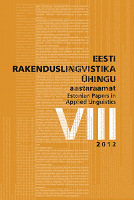Algupäraste ja tõlgitud eestikeelsete tekstide eristatavusest ning neile omistatud omadustest
On the identifiability and characteristics of translations
Author(s): Marju TaukarSubject(s): Language and Literature Studies
Published by: Eesti Rakenduslingvistika Ühing (ERÜ)
Keywords: translational language; descriptive translation studies; translation universals; Estonian
Summary/Abstract: The focus of descriptive translation studies has for a few decades been on translated language in the context of non-translated language. The impulse for research has been an attitude that translations in a language differ linguistically from non-translations in the same language. Even though the difference is usually stressed as not deriving from straightforward mistakes, the common attitude towards translations and also the prevailing view of translations in the study discussed in this article is that there is something wrong with the translation. The aim of the study was to investigate whether readers can distinguish between translations and non-translations in Estonian and what linguistic features are described as creating the impression of a translation or a non-translation. The two broad features that, according to respondents, indicate non-translationality are a flowing, fluent text and creative vocabulary. Features suggesting that a text is a translation are deviations from the linguistic norm (or what the respondent regards as the norm) and unnatural lexical strings. The article places the study in the context where transla- tion universals have been sought for to show what lies behind the impression of strangeness claimed present in translations. This context involves also a discussion of the critique of translation universals.
Journal: Eesti Rakenduslingvistika Ühingu aastaraamat
- Issue Year: 2012
- Issue No: 8
- Page Range: 245-256
- Page Count: 11
- Language: Estonian

